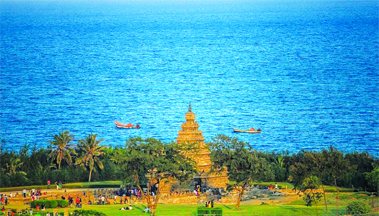Famous for its intricately carved temples and rock-cut caves, Mamallapuram or Mahabalipuram as it is famously known, is a historically important and well-loved tourist location situated on the Coromandel Coast along the Bay of Bengal, in the state of Tamil Nadu. Once the abode of the famous demon king Mahabali, Mahabalipuram was later renamed Mamallapuram.
The serenity, the alluring atmosphere and the impressive setting with many beautiful white sandy beaches dotted with casuarina trees are all reasons as to why one would want to visit this wonderful town. Some famous tourist spots include the UNESCO world heritage site Group of Monuments like the Shore Temple and the Five Rathas, the Crocodile Bank which is home to some exquisite species of crocodiles and alligators, and the beach resorts in Kovalam and Sadras.
Shore Temple
Built during the 7th century, Shore Temple is one of the oldest South Indian temples constructed in the Dravidian style and depicts the royal taste of the Pallava dynasty. The work of the temple has been listed amongst the World Heritage Sites by UNESCO. It is located in Mahabalipuram and is one of the most photographed monuments in India situated on the shores of Bay of Bengal.
As per legends, the Shore Temple was a part of the Seven Pagodas in Mahabalipuram. Seven Pagodas is an old Hindu legend. As history has it, Prince Hiranyakasipu did not believe in Lord Vishnu. However, his son Prahlada was a great devotee of Lord Vishnu which forced Prince Hiranyakasipu to banish Prahlada from the kingdom. Prahlada was the welcomed after a while after which he went on and became the king. He had a grandson named Bali who also founded Mahabalipuram.
Shore Temple was given the name ‘Seven Pagodas’ after they saw such a tall structure standing alongside the seashore. This temple was like a landmark for the navigating ships. Also, the structure resembled that of a Pagoda and hence the familiarity.
After Tsunami hit the coastline of Coromandel in 2004, an old distorted temple was exposed in the process. This temple was made up of granite only. After this event, the news of Mahabalipuram being a part of the Seven Pagodas as mentioned in the diaries of Europeans began doing the rounds. It was also stated that out of temples, six of them remain sunken in the sea. The Tsunami also brought to light some old sculptures of elephants, peacocks and lions which were used to decorate the walls of the temples during the reign of the Pallavas in the 7th and 8th century.
Five Rathas
The Five Rathas, also known as Panch Rathas, is a exemplary set of rock temples. They are excellent examples of the evolution of Dravidian style architecture.
These temples are built in the same shape as pagodas, and greatly resemble Buddhist shrines and monasteries. The rathas are associated with the great epic Mahabharata. The first ratha that is located right by the entrance gate is Draupadi’s Ratha. It is shaped like a hut and is dedicated to the goddess Durga. Next comes Arjuna’s Rath. This one has a small portico and carved pillar stones and is dedicated to Lord Shiva. There are no carvings inside this temple, but many are on the outside. Directly in front of Arjuna’s Rath is the Nakula Sahadev Rath. This ratha has some huge elephant sculptures included that are a huge draw for the Five Rathas. It is dedicated to the God of Rain, Lord Indra. The Bhima Rath is huge. It measures 42 ft in length, 24ft in width, and 25ft in height. The pillars there do contain lion carvings even though the ratha as a whole is incomplete. The largest of the Five Rathas is the Dharamraja Yudhistar’s Rath. This rath is also dedicated to Lord Shiva and is a gr
Arjuna’s Penance
The Arjuna’s Penance is an enormous rock-cut relief, one of the largest in the whole world, situated in Mahabalipuram of Kanchipuram district, Tamil Nadu. It is also known by the name ‘Descent of the Ganges’ because the structure depicts either or both of these two significant and symbolic events of Hindu mythology; thus making this attraction spot a favourite among historians, scholars, academics as well as tourists who are enthusiastic about the cultural past of India.
Mahabalipuram Beach
Also known as Mamallapuram by locals, Mahabalipuram Beach is 58 km from Chennai city in Tamil Nadu. The beach lies on the shore of the Bay of Bengal and comprises some rock-cut sculptures. The scintillating beach has golden sand all along the stretch and is also famous for caves, massive rathas, chariots and temples. The surfers and swimming lovers are bound to have an amazing time at the beach.
The beach also has interesting places to attract tourists, including a crocodile bank with about 5000 crocodiles belonging to 6 different species, a school of art & sculpture and a snake venom extracting centre. There are also numerous resorts along the beach offering delicious food joints.
Mahabalipuram is a town mostly known for its shore temples which were constructed by Rajasimha, the king of Pallavas in old times. The coast stretches for about 20 km, and numerous lovely beaches are along the coastline. Also, at this captivating beauty of Mahabalipuram a dance festival is organised by the Department of Tourism of the Government of Tamil Nadu every year, where one can see extremely talented classical dancers performing against the backdrop of the sea.
Mahabalipuram: Drenched in an enigmatic old-age charm
